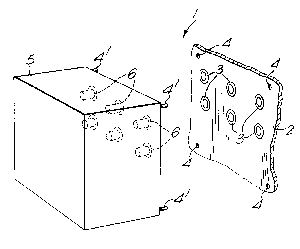Some of the information on this Web page has been provided by external sources. The Government of Canada is not responsible for the accuracy, reliability or currency of the information supplied by external sources. Users wishing to rely upon this information should consult directly with the source of the information. Content provided by external sources is not subject to official languages, privacy and accessibility requirements.
Any discrepancies in the text and image of the Claims and Abstract are due to differing posting times. Text of the Claims and Abstract are posted:
| (12) Patent Application: | (11) CA 2209650 |
|---|---|
| (54) English Title: | ELECTRICAL COMPONENTS AND APPARATUS |
| (54) French Title: | COMPOSANTS ET APPAREILS ELECTRIQUES |
| Status: | Deemed Abandoned and Beyond the Period of Reinstatement - Pending Response to Notice of Disregarded Communication |
| (51) International Patent Classification (IPC): |
|
|---|---|
| (72) Inventors : |
|
| (73) Owners : |
|
| (71) Applicants : |
|
| (74) Agent: | SMART & BIGGAR LP |
| (74) Associate agent: | |
| (45) Issued: | |
| (22) Filed Date: | 1997-07-03 |
| (41) Open to Public Inspection: | 1998-01-04 |
| Availability of licence: | N/A |
| Dedicated to the Public: | N/A |
| (25) Language of filing: | English |
| Patent Cooperation Treaty (PCT): | No |
|---|
| (30) Application Priority Data: | ||||||
|---|---|---|---|---|---|---|
|
Conventional contact pads are used to make electrical interconnection with electrical
apparatus. In the present invention, the contact has a metal housing with a threaded bore
opening at one end into a circular well. A plated contact pad has a threaded stem screwed into
the bore and a circular pad member recessed in the well. The pad member has several cut-outs
around its edge, which are engageable by projections on a cooperating tool by which the
contact can be inserted and removed from the housing. Contact to the housing is made by
conductor secured to the housing by means of a bolt inserted in the rear end of the bore.
Des pastilles de contact classiques sont utilisées pour effectuer l'interconnexion électrique avec des appareils électriques. Dans la présente invention, le contact comporte un boîtier métallique présentant à une extrémité une ouverture filetée aboutissant dans un logement circulaire. Une pastille de contact plaquée comporte une tige filetée qui est vissée dans l'ouverture, ainsi qu'un élément circulaire encastré dans le logement. L'élément circulaire présente sur ses bords plusieurs encoches dans lesquelles peuvent s'engager les saillies d'un outil permettant d'insérer le contact dans le boîtier et de l'en retirer. Le contact avec le boîtier se fait au moyen d'un conducteur qui est fixé audit boîtier au moyen d'un boulon inséré à l'extrémité arrière de l'ouverture.
Note: Claims are shown in the official language in which they were submitted.
Note: Descriptions are shown in the official language in which they were submitted.

2024-08-01:As part of the Next Generation Patents (NGP) transition, the Canadian Patents Database (CPD) now contains a more detailed Event History, which replicates the Event Log of our new back-office solution.
Please note that "Inactive:" events refers to events no longer in use in our new back-office solution.
For a clearer understanding of the status of the application/patent presented on this page, the site Disclaimer , as well as the definitions for Patent , Event History , Maintenance Fee and Payment History should be consulted.
| Description | Date |
|---|---|
| Inactive: IPC from MCD | 2006-03-12 |
| Inactive: IPC from MCD | 2006-03-12 |
| Application Not Reinstated by Deadline | 2003-07-03 |
| Time Limit for Reversal Expired | 2003-07-03 |
| Deemed Abandoned - Failure to Respond to Maintenance Fee Notice | 2002-07-03 |
| Inactive: Abandon-RFE+Late fee unpaid-Correspondence sent | 2002-07-03 |
| Letter Sent | 2001-08-09 |
| Application Published (Open to Public Inspection) | 1998-01-04 |
| Inactive: Filing certificate - No RFE (English) | 1997-11-06 |
| Classification Modified | 1997-10-08 |
| Inactive: First IPC assigned | 1997-10-08 |
| Inactive: IPC assigned | 1997-10-08 |
| Inactive: Filing certificate correction | 1997-10-03 |
| Inactive: Filing certificate - No RFE (English) | 1997-09-15 |
| Letter Sent | 1997-09-15 |
| Application Received - Regular National | 1997-09-12 |
| Abandonment Date | Reason | Reinstatement Date |
|---|---|---|
| 2002-07-03 |
The last payment was received on 2001-06-07
Note : If the full payment has not been received on or before the date indicated, a further fee may be required which may be one of the following
Patent fees are adjusted on the 1st of January every year. The amounts above are the current amounts if received by December 31 of the current year.
Please refer to the CIPO
Patent Fees
web page to see all current fee amounts.
| Fee Type | Anniversary Year | Due Date | Paid Date |
|---|---|---|---|
| Registration of a document | 1997-07-03 | ||
| Application fee - standard | 1997-07-03 | ||
| MF (application, 2nd anniv.) - standard | 02 | 1999-07-05 | 1999-05-19 |
| MF (application, 3rd anniv.) - standard | 03 | 2000-07-04 | 2000-06-22 |
| MF (application, 4th anniv.) - standard | 04 | 2001-07-03 | 2001-06-07 |
Note: Records showing the ownership history in alphabetical order.
| Current Owners on Record |
|---|
| SMITHS GROUP PLC |
| Past Owners on Record |
|---|
| NEIL ANDREW SWINDLEHURST |